Ornamented Demise
The History of Toledo Steel Blades

Lionel Royer. Vercingetorix Throws Down His Arms at the Feet of Julius Caesar. 1899/Wikimedia commons
Just like other centers renowned for producing famous weapons, the Spanish city of Toledo thrived because it was located near accessible deposits of high-quality iron ore. However, Toledo's steel enjoyed a reputation as the world's finest for a long time. What was the secret behind its exceptional quality? In this article, we aim to decode this mystery!
Toledo’s history with metal work is a longstanding one—people have lived here since ancient times, honing their metalworking skills. In fact, archeologists uncovered the remains of an Iberiani
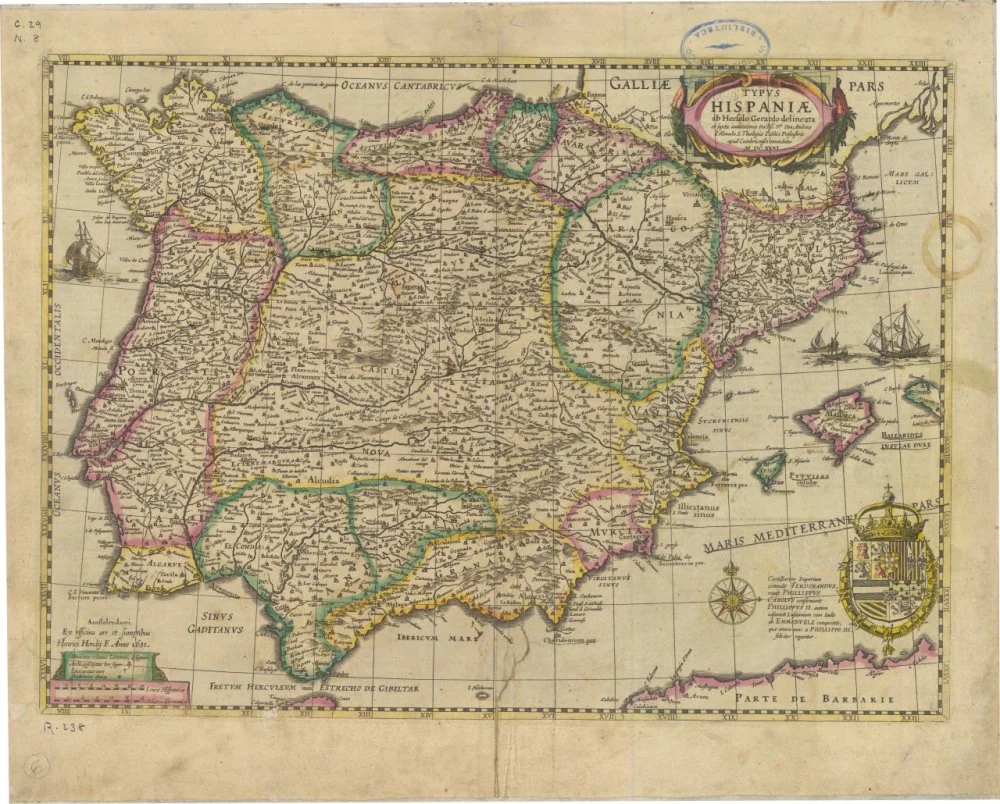
Map of the Iberian Peninsula. 1631/Wikimedia commons
Weapons for Rome
The Romans conquered Iberia, and at the beginning of the second century BCE, they surrounded the Celtic ‘blacksmith center’ with city walls, built the largest Roman circus in Spain, a bridge over the river, an aqueduct to supply the inhabitants with water, public baths, and magnificent villas for wealthy patricians. The city, now firmly Romanized, was called Toletum, a name closely resembling its modern one. It is thought to have originated from the Latin ‘tollitum’, meaning ‘the elevated city’. The ancient Roman historian Titus Livius (59 BCE–17 CE) described Toledo as ‘a small town, but impregnable due to its location’. Indeed, Toledo rises on a hundred-meter hill on the right bank of the Tagus River.
In the city, craftsmen continued to forge remarkable weapons, but now for the Roman army. The soldiers were different, and the style of the weapon changed as well, but the now straight blades did not become any less effective. The Romans called them gladius hispanicus, or the Spanish sword. Roman gladii (swords) from Toletum came in different lengths to suit infantry and cavalrymen and served their new masters exceptionally well.

Blade Toledo, Fortress Solingen, 1640s/Wikimedia commons
The soldiers of King Philip V of Macedon were among the first to confront the impact of the new Roman weaponry during the Second Macedonian War in Greece.i
«Both sides were matched in number and valor, composed of elite warriors, and engaged in combat on equal terms for several hours. As exhaustion took hold of both horses and soldiers, they eventually disengaged without a clear victor ... Philip, seeking to inspire his troops and foster their loyalty, personally oversaw the burial of the horsemen who fell in the skirmish. He arranged for their bodies to be transported to the camp for a grand funeral display ... However, instead of instilling resolve, the spectacle filled the soldiers with dread and despair. Accustomed only to wounds inflicted by spears, arrows, andthe occasional pikes in battles against Greeks and Illyrians, they were shocked by the gruesome injuries inflicted by Spanish swords as severed limbs, heads, and entrails were strewn across the battlefield. Witnessing the carnage caused by both the enemy and their weaponry, Philip's soldiers were unnerved. The king himself, having yet to face the full force of Roman warfare, shared their apprehension.»

Giuseppe Sciuti Titus. Quinctius offers the liberty to the Greeks. 1879 Painting showing the period of II Macedonian war/Wikimedia commons
In the third century BC, Philo of Byzantium wrote about swords brought from Spain:
«If they need to be tested, they are taken in the right hand, placed horizontally on the head, and bent down to both sides until they touch the shoulders. Then, both hands are quickly moved aside, and the freely released sword will become straight again and return to its original shape, leaving no trace of bending. No matter how many times this is done, the swords remain straight.»
The Dominance of the Toledo Sword
In the fifth century, after the fall of the Roman Empire, Toledo became the capital of the Visigothic kingdom.i


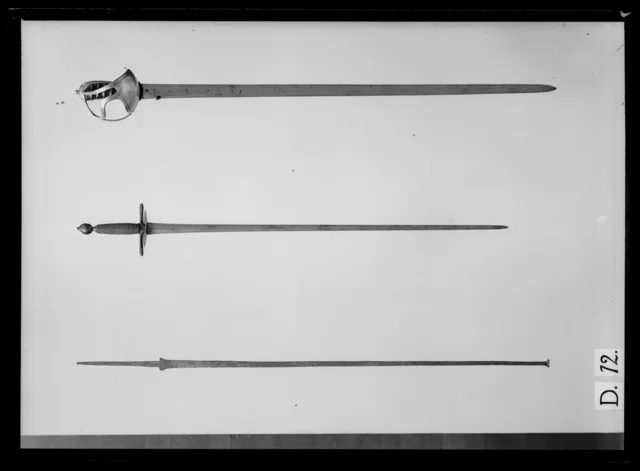
Broadsword, sword, saber.Toledo 1784/Wikimedia commons
Spain, in general, and Spanish swords, in particular, dominated the world until the seventeenth century. Comparing weapons from different countries is quite difficult, but it is worth recalling how the Spaniards, armed with Toledo swords, once encountered the katanas i

In June 1582, at the request of the governor of the Philippines, Captain Juan Pablo de Carrión was sent from Spain with a detachment of forty soldiers to combat pirates. Without hesitation, Tai Fusu, the pirate leader, decided to engage this insignificant ‘force’ in open battle, which would later be known as the Battle of Cagayan. There was no reason for him not to—after all, he commanded 1,600 warriors, of whom up to 500 were Japanese ronin. The outcome of the battle was decided, however, through hand-to-hand combat. The ronin with their famous katanas charged at thirty-eight Spanish soldiers armed with Toledo swords and wearing armor of Toledo steel. The result was that over seventy ronin were killed on the spot (the chronicles do not convey the number of wounded), while the Spanish saw one soldier killed and one wounded. Ultimately, the pirates were utterly defeated; some were killed, and those who could fled.
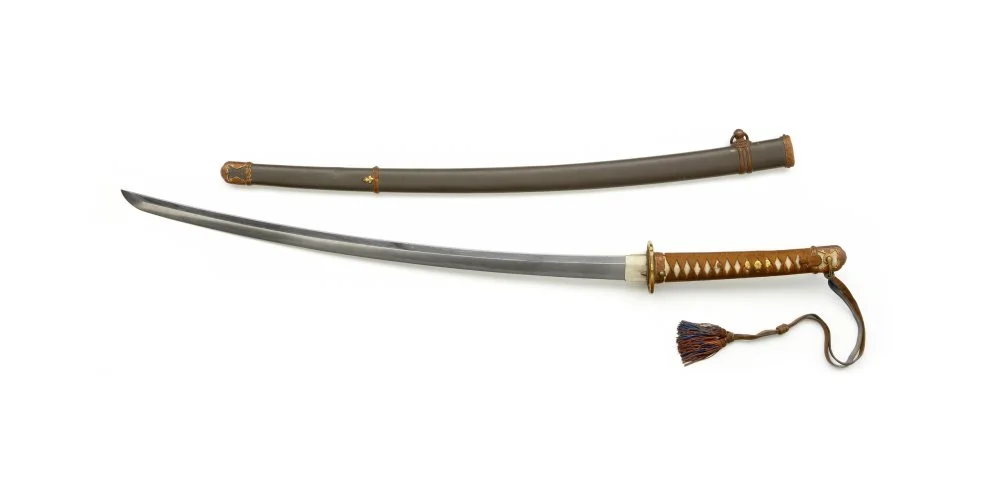
Katana/Getty Images
The Battle of Cagayan vividly demonstrated the superiority of the Spanish fencing style and cold steel weapons. The Spanish school of fencing involved constantly pointing the tip of the blade at the opponent's face, making a frontal attack impossible—the technique of the thrusts to the head might have been inherited from the Roman legionaries. Moreover, their slashes were also very powerful, thanks to the quality of the steel in their swords. When striking enemy weapons or armor, the weapons did not break, and the blades did not chip.
Over time, Toledo steel did not degrade, and the swords forged from it remained just as sharp and durable. However, other powers were emerging on the world stage, one of which was England. Her Majesty's privateer, and later Vice Admiral Francis Drake (died 1596), caused much trouble for the Spaniards, plundering their galleons off the coasts of Spanish colonies. He brought many stolen treasures from the New World to his queen, Elizabeth (1558–1603), that their value was worth several years of England’s annual budget! It is not surprising then that in Spain, Drake was called El Draque, the Dragon, and the King of Spain, Philip II (1556–98), considered him a personal enemy—alongside England, of course.
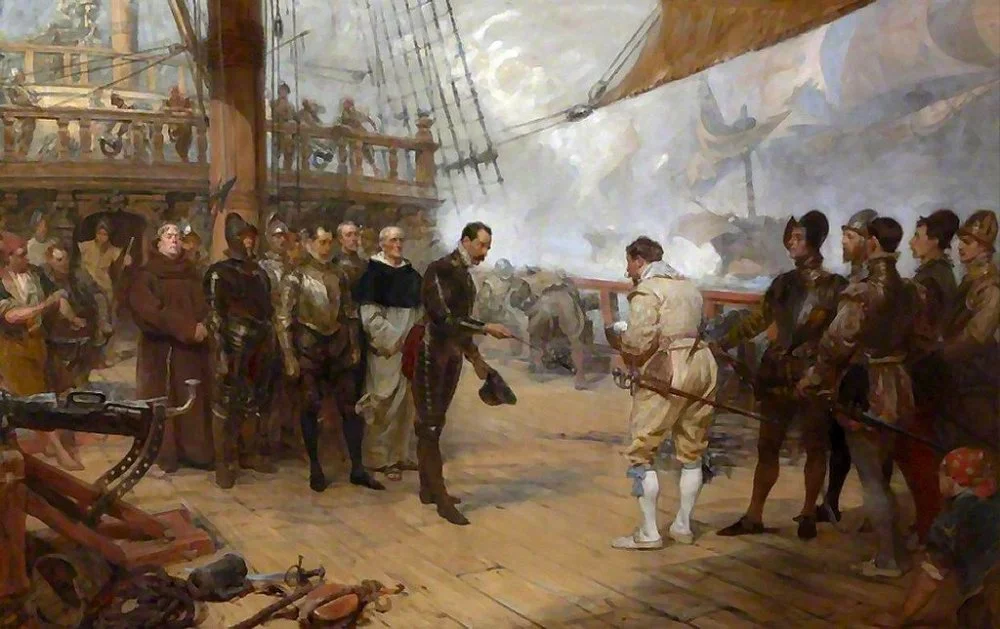
John Seymour Lucas. Valdés surrenders to Francis Drake aboard Revenge. The event took place in 1588. 1889/Wikimedia commons
In 1585, war broke out between Spain and England, and in 1586, Spain began preparing a large fleet for a decisive battle with the English, assembling a force of 130 ships and 30,000 men! This fleet was later mockingly dubbed ‘the Invincible Armada’. The Spaniards themselves simply called it the Armada or the Most Fortunate Armada. In reality, however, the Spaniards were very unlucky—part of the fleet was destroyed and scattered by a storm, and part was sunk by Drake’s sailors. The fact is, the Spaniards relied entirely on boarding,i
On 25 April, the Captain General of the Most Fortunate Armada, Alonso Pérez de Guzmán, Duke of Medina Sidonia, appeared in full regalia at the Lisbon Cathedral to receive the sacred banner of a new crusade against the English heretics. The bishop of Lisbon blessed the participants of the campaign, took the edge of the standard, and handed it to the duke. ‘Let Spanish valor and Toledo steel shine together!’ exclaimed the duke loudly, while adding quietly, ‘I entrust myself to the mercy of the Almighty so that He may lead us to victory.’ Victory did not come to Don Alonso, but the glory of Toledo steel suffered no damage from this loss.
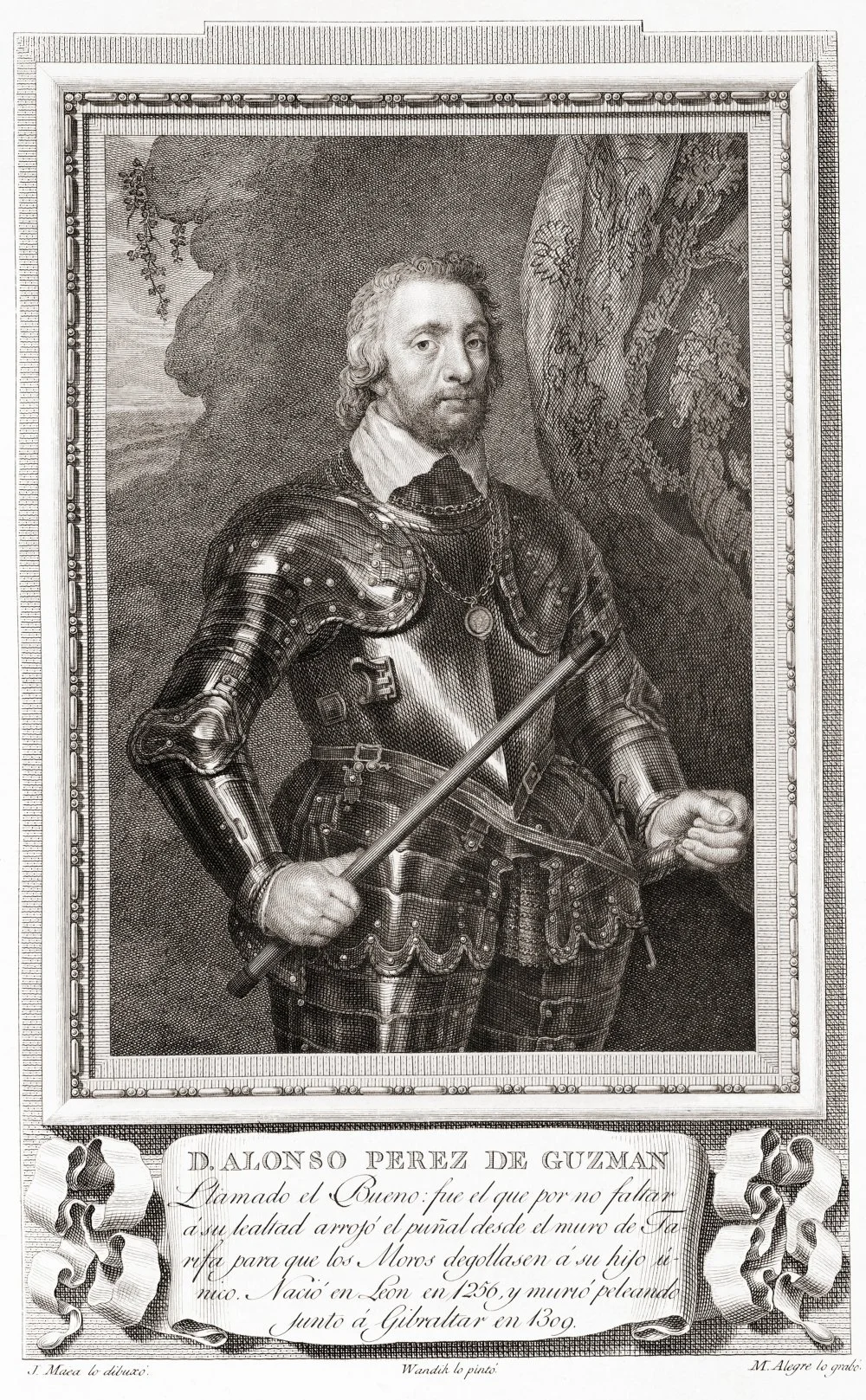
Alonso Pérez de Guzmán, 1256–1309, aka Guzmán el Bueno /Alamy
‘The Color of Liver and the Other Secrets of Toledo
Toledo blades had astonishing properties. They were very hard and durable—the blades didn't notch even when cutting through iron rods. Yet simultaneously these swords also maintained flexibility; their blades could be bent into arcs and straightened without any damage. Of course, any carbon steel, including Toledo steel, can be hardened and sharpened, but such a blade would be brittle. To maintain flexibility, you can lessen the hardening process, which keeps the metal pliable. However, in this case, the blade might get notched if it strikes a hard object.
The secret behind Toledo blades was actually known to many but in practice, it was challenging to implement due to various nuances of the process. Damascus, wootz, bulat are composite steels used to make weapons like the ones in Toledo in different countries. The weapon was forged by welding strips and rods of various types of steel together in a forge. The blade's core was softer and more elastic (alma de hierro, or ‘soul of iron’ as Toledo master craftsmen called it). This was steel with a relatively low carbon content, onto which strips of hard, high-carbon steel, which could be hardened well, were welded on. The entire ‘package’ was repeatedly forged in different directions, which is why its characteristic patterns are visible on the blade surface even after polishing.
In theory, this sounds straightforward, but in practice it was anything but. Today, we understand that steel results from combining iron and carbon, with the proportion of each metal dictating its features. We're familiar with how adding different elements can alter the properties of a metal. However, during the Middle Ages, this knowledge was absent, and craftsmen achieved desired attributes through trial and error. Did this always produce good results? Well, imagine trying to replicate their process in exactly the same way. But what if the ore, charcoal, smelting temperature, hardening, and tempering times are slightly different? What if the water or oil temperature for hardening are different? There are, clearly, too many variables to consider, and success isn't guaranteed.
In those distant times, there were no thermometers or accurate clocks, and so blacksmiths invented various methods to control time. For example, the hardening time of a blade was measured by the number of prayers and psalms recited. Each time, the same Catholic prayers were recited at the same pace to ensure the duration remained the same. Medieval metallurgists surmised that combining hot iron ore with various substances and exposing it to the air changed its properties. Therefore, they experimented by adding different types of charcoal, crushed bull horns, river sand, or graphite to their clay furnaces, observed the outcomes, and selected the best combinations. But how could they tell if the alloy was ready or not? They judged it on how it looked and on its color. For example, medieval recipes recommended removing the workpiece from the furnace when it acquired ‘the color of liver’.

Ernst Josephson. Spanish Blacksmiths/Wikimedia commons
The blade had to be hard and hold a sharp edge well, but over-hardening was dangerous as it could make the blade brittle. The hardness of the tempering was also determined by the sound produced by striking the blade against iron. Over-hardened blades needed to be tempered—which consisted of reheating the blade and then plunging it into water only horizontally (and never vertically) so that the entire blade was immersed simultaneously. Otherwise, the weapon could crack due to the uneven thermal expansion of its parts.
The choice of water or oil was also deliberate. There is a legend that Toledo swords struck down enemies instantly because they were tempered in the waters of the Tagus River. Indeed, many masters would plunge the blades into the damp sand on the banks of this river after the process of tempering. Who knows how the minerals in the sand affected the steel—perhaps it was the temperature of the sand that played a crucial role. That would be understandable, but there are even more exotic recipes that have survived to this day, such as tempering the blade in donkey urine, mountain winds (instead of street air), ram bile, or fresh manure. In short, there was no science to the art, just pure practice.
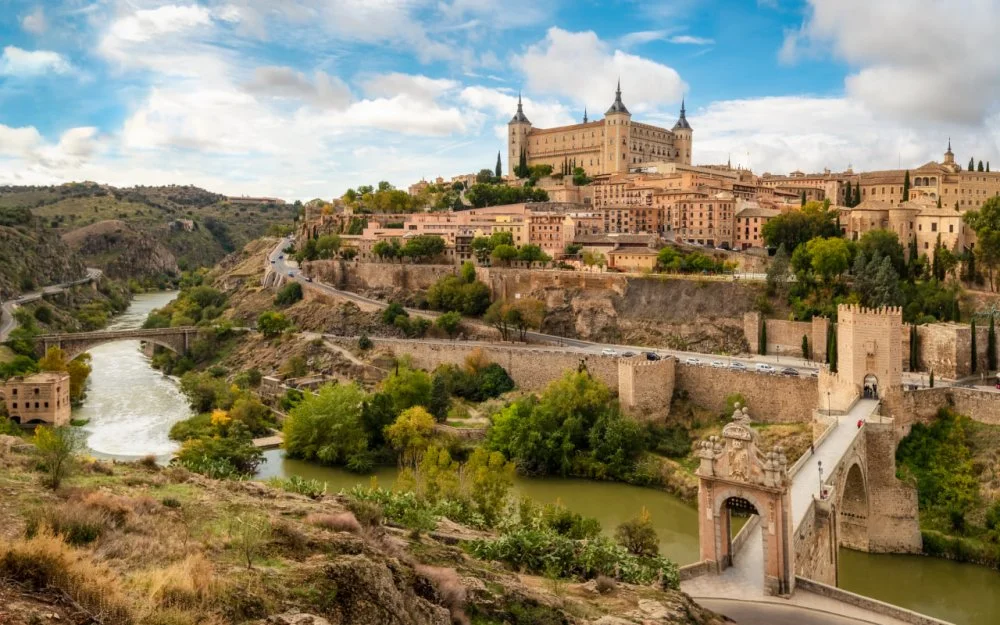
San Martin's Bridge crossing the river Tagus in Toledo/Getty Images
Tempered swords were tested by attempting to cut through a knight's steel helmet or another hard object. Different masters had different standards, but in any case, the blade had to be free of notches, chips, or dents—just a perfect cutting edge.
The masters also tested the flexibility of the sword in various ways. They placed the blade on a special cushion and bent it at different points from the hilt to the tip. Some pressed the blade's tip into a lead plate, bending and twisting it in different directions. After all these tests, the weapon had to remain in its original shape, without any distortions.
The Moors, who occupied Toledo for a while, introduced the tradition of jeweled decorations on the swords. On the blackened steel of the blade, they carved fine grooves into which they embedded gold or silver threads hammered in with a mallet. However, this was purely decorative and did not affect the quality of the weapon. Nevertheless, these patterns distinguished the excellent Toledo swords from other European weapons.

Rapier of Prince-Elector Christian II of Saxony (1583–1611)/Wikimedia commons
In the late fifteenth century, swords with narrow blades suitable for thrusting began to be produced as cutting through increasingly strong armor had become difficult. Such swords were also used for everyday wear with regular clothing, not just with armor, as they were much lighter than the previous wide-bladed ones. This type of weapon in Spain was called espadas roperas, or ‘clothing swords’, and this is where the familiar terms ‘rapier’ and ‘sword’ originate. In the weapon shops of Toledo, these fashionable rapiers were sold coiled in a circle. They could be worn as a belt, which, when necessary, would straighten in the hand with a light hum into a deadly blade.
The Decline of Toledo
In the eighteenth and nineteenth centuries, Europe learned how to produce high-carbon cast steel instead of complex composite steel. Of course, this allowed weapons to be produced at a much faster pace as there was no longer a need to combine billets of different types of steel with different properties—you now simply flattened a solid bar. Moreover, the blades were also quite hard and retained their sharpness for a long time. Yes, they were brittle, and achieving the flexibility of Toledo or Damascus steel was out of the question, but they were produced quickly, in large quantities, and at a relatively low cost. To imitate the pattern of welded steel, craftsmen artificially applied a similar design to the blades. The development of weapons from homogeneous alloy steels posed serious competition to composite forged weapons, contributing significantly to the decline of Toledo's weapon production industry. But, in essence, the era of cold weapons was also coming to an end—sabers and swords could no longer compete with the new types of weaponry.
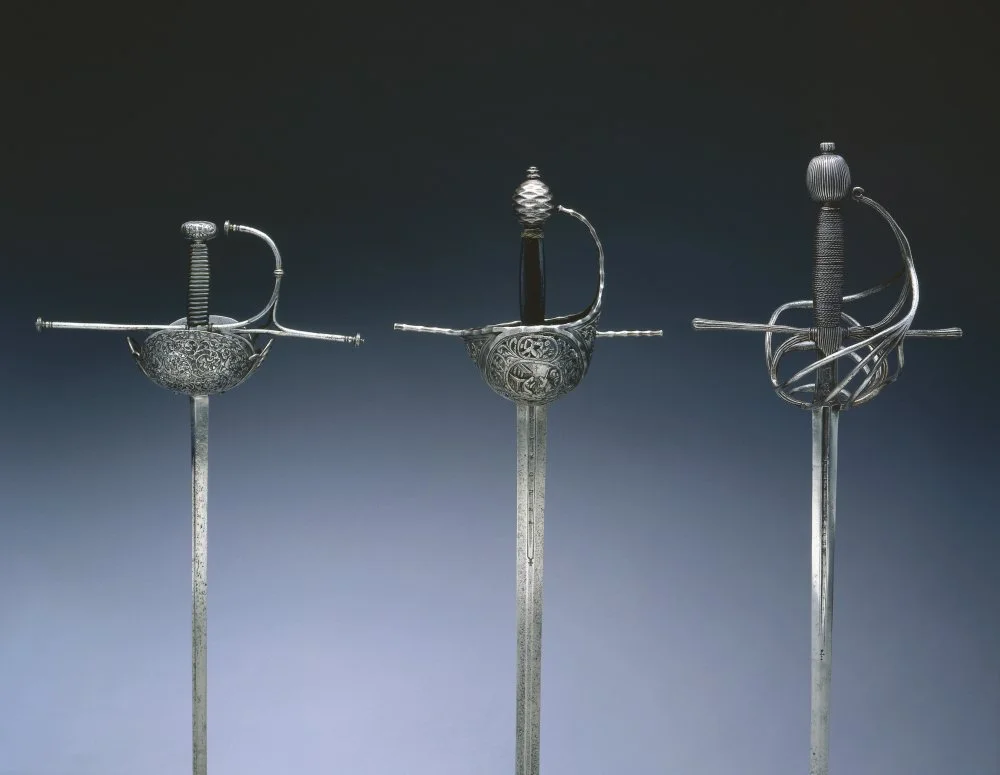
Blade, Spain, Toledo, Belluno, late 16th-early 17th Century/Wikimedia commons
In 1761, King Carlos III founded the Real Fábrica de Espadas de Toledo (Royal Sword Factory of Toledo), which supplied weapons to the Spanish army. Although at that time, armies around the world already preferred using firearms, various modifications in terms of cutting weapons remained in demand for the cavalry, and the sword continued to be an indispensable attribute of the noble classes. In the nineteenth century, the factory implemented modern hydraulic hammers, which nearly doubled the production of blades—by hand, a blacksmith could forge only two or three swords per year. Weapons were produced here until 1996, after which the factory had to be closed. In its final years, the industry was openly struggling, and the famous Toledo steel had not been available since the late nineteenth century. Instead, they used billets from a metallurgical plant in Bilbao in northern Spain. Nevertheless, even today in Toledo, there are still craftsmen who preserve the ancient traditions of local weapon-makers and forge blades using old techniques. Of course, these are now collector's items, although they are eagerly purchased for historical reenactments and film productions. For instance, the actors in Peter Jackson's renowned The Lord of the Rings film trilogy wielded swords crafted in Toledo.
Today, tourists visiting Toledo have the chance to purchase an ‘authentic’ forged sword. However, be prepared to spend between 200 and 2,000 euros for one of these pieces. It's also important to note that while these swords are expertly crafted, they lack the tempering process that would make them true combat weapons because the laws in Spain strictly prohibit the sale of fully functional combat weaponry.

Blacksmith Hammering Hot Iron. Toledo, Spain/Inuk Studio/Stocksy



